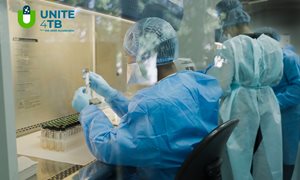
An old antibiotic previously used against leprosy has proven to be safe and effective for patients infected with non-tuberculous mycobacteria (NTM). This drug is now getting a second chance as researchers at Radboud university medical center have demonstrated in various studies that it is not only safe but also more effective than current treatments for the difficult-to-treat NTM infections. A change in treatment guidelines is the next step.
For years, Radboudumc has been researching NTM bacteria, which can cause difficult-to-treat infections leading to permanent lung damage. Pulmonologist Wouter Hoefsloot and microbiologist Jakko van Ingen rediscovered an old leprosy drug, clofazimine, and investigated its safety and effectiveness in treating NTM infections. The results are promising.
Jakko van Ingen stated, 'We could demonstrate that clofazimine is much more effective than rifampicin in treating NTM infections. Rifampicin, the drug currently recommended in guidelines, is difficult to use and has serious side effects. By slightly increasing the dosage of clofazimine, we can not only replace rifampicin but also make the treatment more effective. This is so encouraging that it's already leading to a shift in how we treat these complex infections locally.'
These findings are described in six published scientific articles. Radboudumc led the research, being the only Dutch center of expertise for NTM infections. The studies on this orphan drug range from laboratory research to clinical trials, covering all aspects: safety, effectiveness, and dosage. Another clinical trial is underway to assess the safety of a higher dose.
Bacteria in the air and tap water
We all come into contact daily with NTM, which are found in (tap) water and the soil. There are 200 species, a few of which can cause infections in humans. Humans are not contagious and cannot transmit the bacteria, unlike with tuberculosis bacteria. The disease affects 1 in 20,000 people in the Netherlands, causing symptoms such as chronic cough, weight loss, fatigue, and shortness of breath. NTM infections are difficult to treat; the current therapy consists of a course of multiple antibiotics lasting 18 to 24 months, yet one-third of patients cannot be cured even with this treatment.
Repurposing of drugs
The reuse of clofazimine is an example of drug repurposing, whereby existing drugs are repurposed for new treatment applications. This approach to drug development offers enormous potential for treating various and often rare conditions. Moreover, it is attractive for the healthcare system because it involves drugs without patents. These drugs are already available, affordable, and much is already known about their safety.
Leprosy scarce in the Netherlands
Leprosy is a contagious infectious disease caused by bacteria and is transmitted through coughing and sneezing. Leprosy can lead to severe deformities of hands, feet, and the face. Globally, there are about 200,000 new patients each year, mainly in Indonesia, India, and Brazil. In the Netherlands, the disease is rare, with barely 5 to 10 cases per year. People acquire this infection abroad.
More information about the scientific publications
- Why do we use 100mg of clofazimine in TB and NTM treatment? (2024).
- Clofazimine as a substitute for rifampicin improves efficacy of Mycobacterium avium pulmonary disease treatment in the hollow-fiber model (2024).
- Clofazimine Is a Safe and Effective Alternative for Rifampicin in Mycobacterium avium Complex Pulmonary Disease Treatment: Outcomes of a Randomized Trial (2023).
- RNA Sequencing Elucidates Drug-Specific Mechanisms of Antibiotic Tolerance and Resistance in Mycobacterium abscessus (2022).
- Clofazimine does not lead to significant QT interval prolongation: a multicentre study (2018).
- Clofazimine Prevents the Regrowth of Mycobacterium abscessus and Mycobacterium avium Type Strains Exposed to Amikacin and Clarithromycin (2016).
Photographer: Merlin Daleman.
-
Want to know more about these subjects? Click on the buttons below for more news.
More information
Pauline Dekhuijzen

wetenschaps- en persvoorlichter






